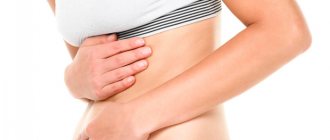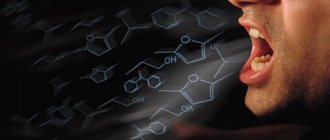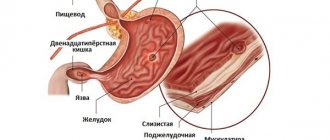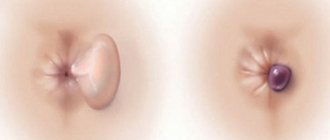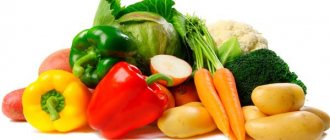Increased gas formation or flatulence is a fairly common phenomenon, accompanied by bloating, in which digestive gases accumulated in the intestines are abundantly and involuntarily released. This problem can affect even a healthy person: when overeating, the presence of foods containing carbohydrates and plant fiber, carbonated drinks, etc. in the menu.
The intestines and stomach of the average adult contain approximately 1 liter. gases, from 0.1 to 0.5 liters are released per day. With flatulence, the release of gas reaches 3 or more liters. Gas release or flatulence - can have a voluntary or involuntary release, accompanied by a characteristic pronounced sound with an unpleasant odor.
The foul odor depends on the food consumed and on the presence in the gases of a substance such as hydrogen sulfide, produced during the life of intestinal bacteria. With a proper and balanced diet, gas emissions are not as foul-smelling, or may have no odor at all.
What it is?
Gases in the intestines are a foamy mucous mass. When there are a lot of them, they can block the lumen of the digestive tract, creating difficulties for normal digestion and absorption of foods. At the same time, the activity of enzyme systems decreases, and indigestion occurs.
In a healthy human digestive tract there is approximately a liter of gases; if any disturbances occur, up to three liters can be formed. What does it contain? The most common connections are:
- oxygen;
- hydrogen;
- nitrogen;
- carbon dioxide;
- methane;
- ammonia;
- hydrogen sulfide.
A specific unpleasant odor is felt if hydrogen sulfide, indole or skatole are present in the composition. These substances are formed when the intestinal flora processes undigested food residues.
Removal of gases from the intestines occurs as a result of their release from the anus, which can be controlled or involuntary. This process is called flatus, or flatulence.
Causes of increased gas formation
The mechanism of excessive gas production may be pathological (caused by a serious illness) or non-pathological:
| Pathological causes | Non-pathological causes |
|
|
If the symptoms of excess gas formation are not associated with eating habits, lifestyle or aerophagia, they may indicate the presence of the following pathologies:
- dysbacteriosis;
- pancreatitis;
- hepatitis, cirrhosis, bile outflow disorders;
- chronic constipation;
- ulcerative lesions of the stomach and intestines;
- inflammation in the intestines (colitis, enteritis);
- peritonitis;
- portal hypertension (increased pressure in the hepatic and inferior vena cava);
- intestinal obstruction;
- haemorrhoids;
- appendicitis;
- helminthiasis;
- intestinal infections;
- neoplasms in the intestines;
- hormonal dysfunctions;
- impaired absorption of glucose and galactose;
- celiac disease (gluten intolerance).
Flatulence caused by non-pathological processes can be easily eliminated. If excessive gas formation is caused by a disease of the gastrointestinal tract (gastrointestinal tract), competent diagnosis and an integrated approach to treatment are required.
Causes of flatulence in adults
Normally, the intestines of a healthy adult contain from 200 to 900 milliliters of gas. Approximately 500 milliliters are released per day, and the most common places of accumulation are the bottom of the stomach and intestines.
Flatulence is spoken of in cases where there is an excessive accumulation of gases, and in the loops of this organ its volume can reach three liters. In such situations, the number of episodes of its release through the rectum can reach thirty or more times, while normally this should occur no more than twenty times. A large number of provoking factors can cause the appearance of severe flatulence, which is why they are usually divided into pathological and physiological.
The first category of causes is represented by typical diseases in which the expression of a similar symptom is observed. These include:
- insufficient production of pancreatic hormones;
- lactose or gluten intolerance;
- irritable bowel syndrome;
- oncological lesions of the duodenum or other organs of the gastrointestinal tract;
- pathological influence of helminths, protozoa and parasites;
- intestinal obstruction;
- pathologies of the digestive system - flatulence is most often observed with gastritis of any nature, duodenitis, pancreatitis, colitis, enterocolitis and cholelithiasis;
- neuroses and psycho-emotional stress;
- intestinal dysbiosis;
- the course of intestinal infections in acute form;
- development of postcholecystectomy syndrome - a similar condition develops after the patient has undergone surgery to remove the gallbladder;
- chronic constipation;
- liver cirrhosis of alcoholic origin;
- pneumonia in children;
- intestinal stenosis or tuberculosis;
- peritonitis;
- inflammatory process in the peritoneum;
- the formation of tumors or adhesions in the rectum. This should also include increased gas production during hemorrhoids, since against the background of such a disease new growths appear in the form of external or internal hemorrhoidal cones.
The physiological causes of flatulence are presented:
- swallowing large amounts of air while eating;
- poor nutrition, in which the basis of a person’s menu is made up of hard-to-digest carbohydrates;
- the habit of washing down food with carbonated drinks, not only sweet ones, but also kvass, beer and champagne;
- uncontrolled use of medications, an overdose of which leads to the occurrence of such a disorder. Most often this occurs due to the abuse of antibacterial substances.
Very often the expression of a similar symptom occurs after eating, which is caused by the consumption of the following ingredients:
- pears and grapes, apples and peaches;
- fresh baked goods and confectionery;
- whole grains;
- ice cream and hard cheese;
- legumes;
- mushrooms and any varieties of cabbage;
- onions, garlic and artichokes;
- radishes, turnips and radishes;
- fat milk and fermented milk products;
- porridge, with the exception of rice.
This should also include all foods enriched with fiber and starch, since they contribute to the development of fermentation processes in the intestines.
Separately, it is worth noting about the causes of intestinal flatulence in women - any hormonal disorders lead to increased gas formation and bloating, for example, a similar condition very often develops during menopause or during pregnancy. Moreover, flatulence in pregnant women is observed both in the early and late stages of intrauterine development of the fetus.
The appearance of such a symptom in infants is considered a completely harmless phenomenon - in such cases, its occurrence is associated with imperfections in the children's digestive system. However, it is worth noting that this only applies to situations where there are no additional clinical signs.
Flatulence in older children is formed against the background of the above reasons or addiction to bad habits, namely smoking cigarettes.
What foods cause bloating and gas?
Increased gas formation is observed when consuming foods that contain carbohydrates, while fats and proteins have a much lesser effect on this process. Carbohydrates include: raffinose, lactose, as well as fructose and sorbitol.
- Raffinose is a carbohydrate found in legumes, pumpkin, broccoli, Brussels sprouts, asparagus, artichokes and many other vegetables.
- Lactose is a natural disaccharide that is present in milk and components containing it: ice cream, bread, breakfast cereals, salad dressings, milk powder.
- Fructose is a carbohydrate found in many fruits and vegetables. In addition, it is used in the production of soft drinks and juices. Fructose is used widely and as an excipient in various medications.
- Sorbitol is a carbohydrate found in vegetables and fruits. It is widely used to sweeten all kinds of sugar-free dietary products.
- Starch, which is contained in most foods consumed by the Slavs (potatoes, corn, peas and wheat), also provokes gas formation. The only product that does not lead to bloating and increased gas formation is rice.
Let's talk about dietary fiber, which is present in almost all products. These fibers can be soluble or insoluble. Thus, soluble dietary fiber (or pectin) swells in water, forming a gel-like mass. Such fibers are found in oats and beans, peas and many fruits. They enter the large intestine unchanged, where the breakdown process produces gas. In turn, insoluble fibers travel through the gastrointestinal tract practically unchanged, and therefore do not entail significant gas formation.
Symptoms
Gases in the intestines are a foamy mucous mass. When there are a lot of them, they can block the lumen of the digestive tract, creating difficulties for normal digestion and absorption of foods. At the same time, the activity of enzyme systems decreases, and indigestion occurs.
The accumulation of gases in the intestines leads to obvious signs of flatulence, which indicates a violation of intestinal motility and functions and causes unpleasant symptoms:
- bloating;
- belching when the contents are thrown back into the stomach;
- increased gas formation after eating;
- the appearance of sounds in the stomach when mixing products;
- constipation followed by diarrhea due to constant accumulation of gases in the intestines;
- pain and cramps in the abdomen;
- distension of the intestinal walls, when a distended intestine is diagnosed diagnostically;
- motor impairment;
- general weakness, insomnia, worsening mood, apathy, lethargy.
The signs are most pronounced in the afternoon, when all systems and organs are actively working. Treatment will depend on the reasons that provoke its appearance and on the characteristics of the person’s diet.
Gases in the intestines themselves do not pose a danger to the body. However, they can be a sign of a fairly serious illness, even cancer.
Flatulence - symptoms
If an adult develops pronounced signs of flatulence, the mood noticeably drops, bowel movements are disrupted, and appetite decreases. It is difficult not to notice such unpleasant changes; in addition to excessive accumulation of gases in the body, prolonged constipation or, conversely, prolonged diarrhea may be observed. Other obvious symptoms of flatulence in adults are detailed below:
- heartburn;
- colon spasms;
- belching;
- abdominal enlargement;
- nausea, less often – vomiting;
- sleep phase disturbance;
- abdominal pain.
Diagnostics
If a patient complains that he constantly has gas in the intestines, the doctor is obliged to exclude the presence of serious diseases, for which a comprehensive examination of the patient is carried out. It includes physical examination, that is, listening and tapping, and instrumental methods.
Most often, an X-ray of the abdominal cavity is performed, which reveals the presence of gases and the height of the diaphragm. To estimate the amount of gases, rapid introduction of argon into the intestines is used. In this case, it is possible to measure the volume of intestinal gases displaced by argon. In addition, the following diagnostic methods are used:
- FEGDS is an examination of the mucous membrane of the gastrointestinal tract using a special flexible tube with lighting and a miniature camera at the end. This method allows you to take a piece of tissue for examination, if necessary, that is, do a biopsy.
- Colonoscopy. Visual examination of the large intestine with a special device with a camera at the end.
- Coprogram. Laboratory research, stool analysis for enzymatic insufficiency of the digestive system.
- Stool culture. Using this analysis, the presence of intestinal dysbiosis is detected and disturbances in the intestinal microflora are confirmed.
In case of chronic belching, diarrhea and unmotivated weight loss, an endoscopic examination may be prescribed to exclude suspicion of intestinal cancer. In patients with frequent flatulence (gas production), dietary habits are carefully studied in order to exclude from the diet foods that provoke bloating and flatulence.
If lactose deficiency is suspected, the patient is prescribed lactose tolerance tests. In some cases, the doctor may prescribe a study of the patient's daily diet, during which the patient must keep records of his daily diet in a special diary for a certain period of time.
If a patient complains that gases do not pass away in the intestines, frequent bloating and severe pain, the doctor should conduct an examination to exclude intestinal obstruction, ascites (fluid accumulation) or any inflammatory diseases of the gastrointestinal tract.
A thorough examination, adjustment of the diet, and exclusion of provoking factors that cause flatulence will answer the question of why gases are formed in excess quantities in the intestines and what measures to take to get rid of this unpleasant phenomenon.
Causes
They are divided into two large groups: physiological or natural and pathological or painful.
Non-pathological causes
Nutrition
Eating disorders account for up to 80% of all cases of flatulence.
- Products that cause increased gas formation. Many foods release large amounts of gases during the digestion process. These include legumes, fresh vegetables, especially cabbage, radishes and cucumbers, fresh fruits, yeast breads and pastries, bran, mushrooms, beer, oat and corn products.
- Heavy food. Increased gas formation is caused by the consumption of fatty foods, monotonous food, consisting of dishes that are difficult to digest (lamb, fatty pork).
- Dietary disorder. Irregular meals (less than 3-4 times a day), especially large single meals.
- Consumption of incompatible foods. A lot of gases are formed when meat and dairy dishes, baked goods and coarse vegetables are consumed at the same time. The Jews know this feature best of all - they have the concept of “kosher” for this purpose. The basic rule is to consume milk and meat separately, even going as far as storing such food in different refrigerators. According to Jewish rules, after eating meat, 2 to 6 hours must pass (depending on local requirements), and only then can dairy be consumed. The break after milk ranges from 30 minutes to 2 hours. These requirements are based on digestion speed and are reasonable for all people.
- Binge eating. Overeating always ends in flatulence. This is understandable - too much food does not have time to break down properly.
- Intolerance to certain foods. There will definitely be bloating if you eat foods that a person cannot tolerate and there are no enzymes to digest them. This happens with wheat (gluten), dairy products (lactase), mushrooms (chitin, which is not digestible at all), as well as vegetables and fruits to which there is an allergy.
- Behavioral factor. Non-physiological behavior while eating leads to bloating and flatulence: hasty swallowing, talking, habits of eating poorly chewed pieces. During hasty eating and talking, air is swallowed (aerophagia), which gradually accumulates in the intestines. A small amount comes out when burping, but the main amount needs to go all the way to the anal ring.
Be sure to read: How to use a gas tube for newborns: instructions
Pregnancy
Almost all pregnant women experience bloating and accumulation of gases, and there are two reasons for this: changes in hormonal status and compression of the intestines by an enlarged uterus.
For normal fetal development, progesterone is necessary, and a lot of it is produced. One aspect of the hormone’s action is muscle relaxation, of all groups. The intestines also relax, and their motility is impaired. In the second and especially the third trimester, the intestines experience pressure from the pregnant uterus, which makes it difficult to work.
After childbirth, bloating also goes away - if the intestines are healthy, of course.
Menstruation
The menstrual cycle is “commanded” by the hypothalamic-pituitary system, under the influence of which hormones the follicles in the ovaries mature, then the corpus luteum, and if fertilization does not occur, menstruation begins.
Bloating coincides with ovulation, but some women feel it later. The complex process of egg maturation does not always go smoothly, and in general this is normal, since the regulatory mechanisms are very complex and interconnected.
High altitude flatulence
A normal reaction of the body to a decrease in atmospheric phenomena. On the surface of the earth, intestinal gases are under external pressure from the atmosphere, but with increasing altitude this pressure decreases, and the intestines are literally bursting with gases.
The volume of gas increases exactly as much as the atmospheric pressure decreases. Some airplane passengers experience severe discomfort due to this, accompanied by flatulence (gas release through the anus).
Elderly age
Natural aging is accompanied by atrophic processes in all organs, especially pronounced on the mucous membranes. In all people over 65 years of age, digestion is slow and flatulence occurs frequently. With age, not only the mucous layer, but also the muscle layer undergoes atrophy, which is why the length of the intestines increases and the production of digestive enzymes decreases.
Pathological causes
These are painful conditions caused by either increased gas production or impaired absorption. Flatulence occurs with the following diseases:
- inflammatory processes of different parts - gastritis, enteritis, colitis, duodenitis, cholecystitis, pancreatitis;
- cirrhosis of the liver;
- various intestinal infections;
- obstruction;
- irritable bowel syndrome;
- atony;
- neurotic disorders.
With these diseases, the breakdown of protein, the formation of digestive enzymes, the outflow of bile, swelling and deformation of the endocrine glands, degenerative changes in the mucosa and other damage slow down.
The formation of gases is enhanced by an imbalance of intestinal microflora, the formation of toxins, changes in motility, peristalsis and intestinal pressure.
Stress and neurotic spectrum disorders cause intestinal spasms and difficulty in intestinal motility, and a general slowdown in work.
Drugs for the treatment of increased gas formation
Among the medications for gases in the intestines, the following groups of drugs are recommended.
- Antispasmodics. Allows you to get rid of pain in the intestines caused by spasms. An example is duspatalin or no-spa.
- Surfactants. Preparations based on the active component simethicone exhibit antifoaming properties, eliminating gas bubbles and relieving symptoms of flatulence. Among them: meteospasmil, espumisan, gestide.
- Carminative. Helps reduce the formation of gases in the stomach and facilitate their elimination. These are: bromopride, dimethicone and others.
- Enzymatic agents. Bloating often occurs due to a disorder in the body's enzyme system. Taking such drugs will promote more complete digestion of food. Among them: pancreatin, pancreaflate.
- Probiotics. Normalize the composition of intestinal microflora. An example of such drugs: Linex, Hilak Forte, Bifidumbacterin.
- Prokinetics. Lead to increased contractility of the intestinal walls. An example of this group is domperidone, cerucal.
- Adsorbents. They alleviate the patient’s condition with bloating, but remove not only feces and gases from the body, but also useful compounds. These are: polyphepan, activated carbon, enterosgel, medications with bismuth.
If the process of gas formation occurs against the background of an infectious disease, then taking antibacterial agents is indicated. If helminths are detected, anthelmintic drugs are prescribed.
Treatment of bloating in pregnant women and children
During pregnancy, women sometimes have a swollen stomach. This is due to changes in hormonal levels and pressure on the intestines, which is exerted by the growing uterus. Doctors do not recommend that expectant mothers indulge in traditional medicine recipes on their own. Any natural remedy can have an unexpected effect on the body of a woman and child.
Infants often experience pain in the abdominal area due to the accumulation of gases. Pediatricians recommend not using traditional medicine recipes, but regularly performing gymnastics, which will strengthen the baby’s intestinal walls. It wouldn't hurt to massage the abdomen (without active pressure). At the moment of pain, a warm diaper (baby heating pad) applied to the painful area will help.
In order for the disorder to stop bothering you, you should approach treatment comprehensively. Maintaining a healthy diet, taking natural medications, and walking in the fresh air will have a healing effect on the intestines.
If natural recipes and methods do not help, you should consult a doctor; perhaps the situation is caused by other disorders in the body.
Folk remedies for treatment
Alternative treatment methods are no less effective in combating gas pollution. Unlike pharmaceuticals, they are more harmless and are always at hand, so they are simply irreplaceable at home.
Chamomile decoction:
- 1 tbsp. l. dry herbs, pour 200 ml of boiling water and simmer for 10 minutes.
- Leave for half an hour covered in a warm place.
- Take orally twice a day (morning and evening) 30 minutes before meals, 100 ml at a time.
- The course of treatment is 3 weeks.
Herbal infusion:
- Mix dry raw materials of St. John's wort, yarrow and marsh dried grass (20 g each).
- Take 3 tbsp. l. and pour 1 liter of boiling water.
- Leave for 2 hours, then filter.
- Drink ½ tbsp. 5 times a day.
Anise seed decoction:
- Pour 20 g of dry raw material into 1 liter of water.
- Boil and leave until completely cooled.
- After filtering, take ½ tbsp. three times a day.
Causes of flatulence
The causes of flatulence vary depending on age. In infants, in the first days of life, flatulence develops as the digestive system undergoes restructuring. In a newly born baby, the intestines are sterile; during the first hours of life, bacteria necessary for life appear in it. The formation of microflora is accompanied by excessive gas formation. Often an infant suffers from tummy pain due to the fault of the mother: she may eat something inappropriate. Sometimes the baby is forced to be put on artificial nutrition, which also does not have the best effect on the child’s health.
In older children and adults, the causes of flatulence may be the following:
- regular consumption of inappropriate foods;
- nervous tension;
- helminthic infestations;
- infectious intestinal diseases;
- dysbacteriosis;
- Gastrointestinal diseases: colitis, gastritis, pancreatitis, enteritis, liver disease.
Diet and nutrition rules
A specialized diet to get rid of increased gas formation excludes the following foods from the patient’s diet:
- watermelons;
- mushrooms;
- asparagus;
- kvass;
- beer;
- fatty meat (especially lamb), poultry (goose, duck), fish;
- legumes (lentils, peas, beans, chickpeas);
- milk and dairy products (if milk intolerance is present);
- grape;
- cabbage (especially sauerkraut);
- gooseberries;
- sorrel;
- onion;
- tomatoes;
- apples and pears;
- carbonated drinks (it is acceptable to drink 0.2 liters of mineral water, but you cannot drink too much);
- It is better to limit fresh vegetables and introduce them little by little, monitoring the body’s reaction;
- raisin;
- Rye bread;
- chocolate and cocoa;
- coffee;
- Exotic fruits.
What you can eat:
- Low-fat fermented milk products (ryazhenka, kefir, cottage cheese, yogurt). Many gastroenterologists recommend eating probiotic fermented milk products (Activia).
- Boiled and stewed meat, poultry, fish (can be steamed).
- Boiled, steamed or baked vegetables (potatoes, beets, carrots).
- Wheat bread with added bran.
- Porridge made from buckwheat, pearl barley or wheat, prepared without oil.
- Baked or boiled fruits.
The main rules of nutrition for flatulence:
- Calm atmosphere when eating.
- No need to drink when you eat
- You need to follow a meal schedule. Then gastric juice will be released at the right time, which will prevent gas formation.
- There is no need to chew gum, as it increases gastric motility.
- You need to eat often, but in small portions. With this diet, nutrients are broken down better and, accordingly, are absorbed to a greater extent. Then the urge to defecate will be on time, and accordingly, “unnecessary” substances will be removed from the body without having time to rot and ferment
- Food should be eaten warm; food should not be too hot or too cold (as the intestines may be irritated)
- Don't forget about foods that should not be eaten together: (salty and sweet, milk and coarse fiber). These foods are difficult to digest together.
- It is better to eat boiled rather than fried food. Stewed or steamed dishes.
- Salt should be limited to a maximum of 8 mg per day. And liquids - at least 2 liters per day. Thanks to this, feces will be removed at the right time.
If the appearance of flatulence cannot be avoided, you can take measures to get rid of bloating:
- drink an absorbent tablet: activated carbon or preparations based on it;
- brew chamomile tea to ease digestion, or prepare dill water;
- lightly massage the abdominal area in a clockwise circular motion;
- undergo a course of treatment for dysbacteriosis using special medications (recommended only on the advice of a doctor).
Doctors recommend avoiding severe overeating, eating small and often meals (up to 7 times a day), and not talking during meals (when talking while eating, air is swallowed, which then enters the intestines).
Folk remedy for bloating and gas with mustard
Mustard for bloating
Periodically, people suffer from excess gas formation. There are different ways to combat it, both in traditional and folk medicine. Read the article on our website at this link about how to avoid bloating in different situations. From this article you will learn about the causes of this unpleasant symptom.
One of the most effective folk remedies for bloating and gas is mustard. It is an excellent antispasmodic and has antibacterial properties. It increases salivation well, which facilitates the digestion process.
Interesting: According to the results of some studies, it is believed that the active component of mustard is a natural dye - turmeric, which gives it a yellow color.
Mustard can combat bloating, the problem of excessive intestinal gases, and heartburn. To do this, you need to use it regularly. Here are folk remedies for bloating and gas with mustard:
- 0.5-1 teaspoon of yellow mustard per day is enough. You can eat it separately, with some foods, for example, for lunch or dinner. This recipe is suitable if you do not have chronic gastrointestinal diseases.
- Another recipe: dissolve 1 tsp. mustard in a glass of warm water or tea, add honey and drink 1-2 times a day.
It is worth remembering: Frequent bloating and excessive gas formation may indicate problems in the gastrointestinal tract, so you should consult a doctor.
But if you still decide to use traditional medicine, check them for an allergic reaction and start using the prepared products in small portions.
Prevention
Intestinal problems are a common phenomenon in modern society. Poor nutrition, lack of interest in sports and voluntary physical activity often and heavily affects the processes of the digestive system.
Flatulence or increased accumulation of gases in the intestines can be cured, but it is more advisable to prevent its excessive manifestation.
Avoid excessive consumption of carbonated drinks, fatty and poorly digestible foods, lead a healthy lifestyle, drink plenty of clean water, and to avoid aerophagia, replace chewing gum with mint candies. Arrange fasting days for the stomach and leave the intestines alone for such a problem as increased gas formation.
Increased gas formation in the intestines Bloating after eating Irritable bowel syndrome Intestinal dysbiosis Intestinal colitis Intestinal cancer
Diet for flatulence
When experiencing flatulence, it is very important to be physically active. Regular exercise or walks in the fresh air have a beneficial effect on intestinal motility, reducing the manifestation of flatulence. Also, with frequent bloating, it is recommended to avoid nervous tension and stress, as they contribute to the development of spasm of the intestinal muscles, which can subsequently lead to excessive accumulation of gases. That is why compliance with the work and rest regime is a favorable factor in the treatment and prevention of flatulence.
It should also be noted that one of the main components in the treatment of flatulence is a regular and balanced diet.
For flatulence it is recommended:
- Once a week, arrange a fasting day (for example, during the day, eat only pure rice, boiled without salt and spices, or drink kefir);
- eliminate chewing gum;
- stop smoking and drinking alcoholic beverages;
- consume up to two liters of water daily;
- take infusions, teas and decoctions of medicinal herbs (for example, chamomile, mint);
- eat four to five times a day;
- chew food slowly and thoroughly;
- avoid snacking on the go;
- eat often and in small portions (avoid overeating);
- It is recommended to boil, stew or steam food, while fatty and fried foods should be excluded from the diet;
- consume food warm, trying to avoid very hot or cold food;
- Avoid consuming incompatible foods at the same time (for example, salty and sweet);
- If you are lactose intolerant, avoid consuming milk and dairy products (for example, sour cream, yogurt, cottage cheese);
- for constipation, you should increase your consumption of plant foods, as well as foods rich in fiber;
- for diarrhea, it is necessary to reduce the consumption of foods containing fiber;
- consume pureed food (if diarrhea occurs).
| Recommended | Not recommended |
|
|
Sample menu for a day for flatulence No. 1:
- First breakfast: weakly brewed tea, buckwheat porridge with carrots;
- Second breakfast: cottage cheese with sour cream;
- Lunch: pureed vegetable soup, a piece of boiled meat (for example, chicken breast), fruit compote;
- Afternoon snack: jelly with crackers (without salt and seasonings);
- Dinner: rice porridge with carrots and meatballs.
Sample menu for a day for flatulence No. 2:
- First breakfast: mint tea, oatmeal;
- Second breakfast: cheesecakes with sour cream;
- Lunch: vegetable stew, steamed pike perch, fruit compote;
- Afternoon snack: natural apple juice with diet bread;
- Dinner: omelet with steamed cutlet and weakly brewed tea.



